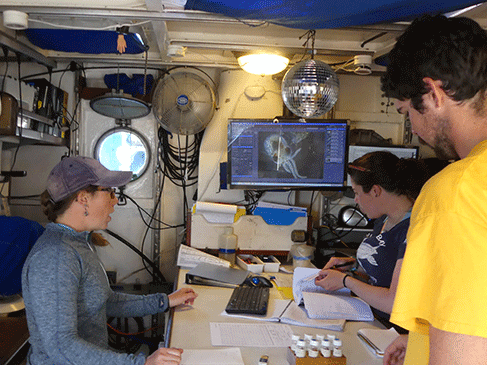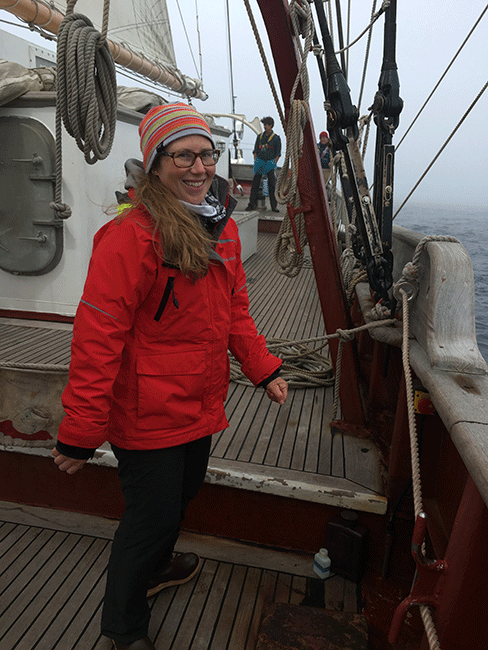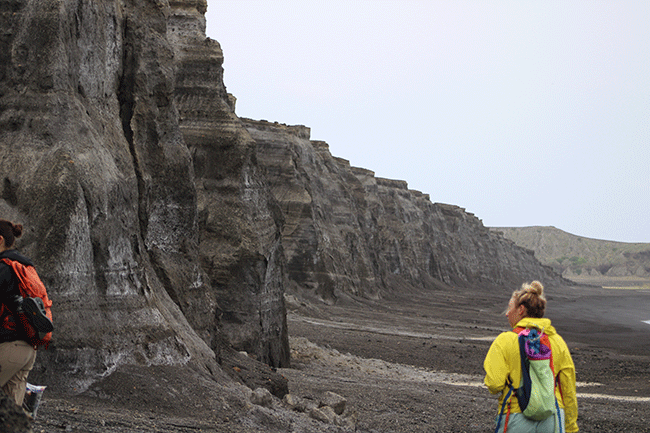News
A Reflection on Ocean Literacy, 2020 and Beyond

Kerry Whittaker, Assistant Professor of Oceanography
With the start of the new year, we are introducing a series of articles by Sea Education Association faculty and staff titled “Study Abroad and the Sea: Perspectives on Climate Change and the Ocean Environment.” The series is a diverse and varied examination of relevant ocean topics for college students interested in ocean research and policy. The first of this series examines the value of ocean literacy by SEA Assistant Professor of Oceanography Kerry Whittaker. 
Here, on this last day of 2019, I find myself reflecting on another year as Oceanography Faculty with SEA. Even today, gazing out onto snow falling along the New England coastline and piling onto branches, railings, and roofs, my mind can easily jump back to the quarterdeck of the Robert C. Seamans carried by the humid trade winds of the South Pacific, or aloft on the Corwith Cramer as we glide through the Bermuda blue water. I find it difficult to neatly wrap up a year of people, far-off places, science, sailing, and moments shared and appreciated on our beautiful blue planet. But for now, I’d like to reflect on a concept that has risen to the surface for me in 2019: that’s the concept of ‘ocean literacy.’
‘Ocean literacy’ is defined as an awareness of the ocean’s influence on you, and your influence on the ocean. In 2019, this concept resonated with me as a scientist and educator. I have the good fortune to spend a chunk of my year sailing on the high seas, areas of the ocean beyond the boundaries of any country, ‘international waters,’ and the ocean commons. I have the privilege of sailing out of cell phone range and tuning-in to the patterns of waves and weather, the physics and biology of marine systems, and to see my students doing the same. I struggle to capture it all, and feel like I’m grasping at ways to communicate this experience. 
I see the tangible connection between students and the ocean as they begin to understand the unique diversity of marine wildlife in those exciting moments of migrating humpback whales breaching off the coast of Tonga, or looking through the microscope to find a glittering squirming world of iridescent Sapphirina copepods, nightmarish lobster larvae (phyllosoma), and ornate nudibranchs.
We encounter plastic in our nets in some of the most remote places on our planet, making it easy to feel the crisis of ocean pollution first-hand, and want to immediately change our personal relationship with single-use plastic. Developing a sense of ‘ocean literacy’ is relatively easy when you have the opportunity to be immersed in a sailing expedition on the open sea. More difficult is communicating our sailing experience with the purpose of expanding ocean literacy beyond the shipboard community.
I witnessed the tangible expansion of ocean literacy this year in moments where students shared their ocean experiences with broad audiences. This year, students of SEA’s Marine Biodiversity and Conservation program (MBC) had the opportunity to conduct oceanographic research by sailing through the North Atlantic, and examine marine biodiversity through DNA analyses. But the marine systems we explore are changing rapidly due to climate change, a global issue rooted in human economies, societies, and governments. In a yearly symposium, MBC students invite experts in marine science, policy, and conservation to SEA’s Woods Hole Campus for a dialogue on marine conservation. At this year’s symposium, MBC students argued that ocean literacy is essential for the conservation of the marine biodiversity that we’re struggling to describe as ocean ecosystems adapt to climate change. Students argued that communities need to understand the essential function of ocean systems, and their importance to human life, before decisions can be made to conserve marine resources and ecosystems. MBC students proposed ways to connect people with the ocean through art, photography, and video, as a way of communicating the value and beauty of the ocean to those who might not have the opportunity to experience it directly.
As follow-on to their presentations at the MBC Symposium, SEA students were invited to present their ideas on ocean literacy to the United Nations (UN) in New York City. The UN is planning for a Decade of Ocean Science for Sustainable Development, 2021-2030, seeking ways to conserve the ocean for the betterment of humanity, and discussing ways to share scientific knowledge of ocean change equitably across the international community. These international efforts are critical as we face the impacts of rapid changes to the ocean through warming, sea level rise, ocean acidification, pollution, overfishing, and resource extraction.
SEA students have the unique opportunity to experience the ocean directly, conduct oceanography in the field, and witness tangible ocean change. In 2019, it was exciting to see the ripple effect of the SEA experience, communicated to UN delegates making international decisions about our global ocean. The exchange between SEA students and UN delegates highlighted the value of ocean literacy on the international stage. But I’m also feeling, more and more, the weight of obligation to share the SEA experience with audiences unable to access the ocean directly. Ocean literacy is not just a novelty; it’s imperative for a sustainable future.
2019 has brought other clear ‘ocean literacy’ moments too. For example, a group of 15 SEA students recently co-authored a scientific paper reporting patterns of genetic diversity among hydroids (coral-like organisms) attached to Sargassum, floating algae adrift in the North Atlantic Gyre.¹ They were able to communicate their peer-reviewed findings to the academic community in an open-access publication.
I’ve seen my colleagues at SEA guide students through the important process of science communication; for example, this year’s Climate and Society students created vibrant and compelling podcasts on issues of marine environmental change.² SEA students merged the history of whaling and scientific studies in a publication in SEA History.³ And this year’s Sustainability in Polynesian Island Cultures and Ecosystem (SPICE) students visited a new volcanic landmass in collaboration with NASA and the Kingdom of Tonga, and communicated their discoveries through interactions with students in Suva, Fiji, blog posts, and an online map journal.(4) I’ve seen the moments of greatest growth and learning occur when SEA students find the words to communicate their experiences and wonder beyond the bounds of a 134-foot sailing vessel.
The ocean has so much to teach us. Every time we throw the dock lines and head out to sea, I know I’ll learn something new about the ocean alongside SEA students and crew. But more and more, I understand the obligation of communicating these experiences beyond our shipmates, and encouraging my students to do so too. I’m looking forward to 2020, with the goal of ocean literacy in mind. I know that my SEA students will grow in their ocean literacy – it’s impossible not to when you’re at sea and have the privilege of tuning into the marine world with microscopes, sensors, and human senses. But, I think ocean literacy is about what we do with our experience once we step on the dock -whom we choose to tell, and how we choose to connect those ocean experiences with others. These aren’t just sea stories or fish tales. This is ocean literacy, and the conservation and sustainability of our ocean depends on it.
1. Govindarajan, A. F., L. Cooney, K. Whittaker, D. Bloch, R. M. Burdorf, S. Canning, C. Carter, S. M. Cellan, F. A. Eriksson, H. Freyer, G. Huston, S. Hutchinson, K. McKeegan, M. Malpani, A. Merkle-Raymond, K. Ouellette, R. Petersen-Rockney, M. Shultz, A. N.S. Siuda (2019). “The distribution and mitochondrial genotype of the hydroid Aglaophenia latecarinata is correlated with its pelagic Sargassum substrate type in the tropical and subtropical western Atlantic Ocean.” PeerJ7: e7814.
2. Climate and Society: Behind the Scenery Podcast: https://soundcloud.com/sea-semester/sets/climate-and-society
3. Sigler, Mia. “When We See Whales”—Transcribing Captain Lawrence’s Logbook. Sea History Magazine, Winter 2019-20. No. 169. https://sea.edu/documents/SeaHistory_Sigler.pdf
4. Sustainability in Polynesian Island Cultures and Ecosystems ArcGIS Storymap Journal: https://arcg.is/1v1L98
Contact: Douglas Karlson, Director of Communications, 508-444-1918 | dkarlson@sea.edu | www.sea.edu